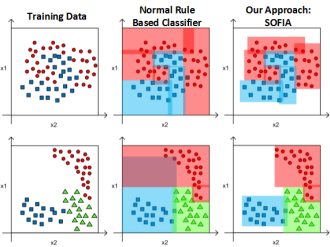Automatic classification is an important application of machine learning
algorithms. It is used in a variety of tasks such as medical image
diagnosis, quality assurance and automatic security checks. In all
these applications the classifier has to deal with real world data,
which is subject to a lot of uncertainties.
As many tasks are
safety critical, these uncertainties have to be monitored and treated
explicitly, during the training of the classifiers and during the actual
classification, to ensure a safe and robust behavior of the classifier.

In our research we focus on methods to deal with uncertain training
data, uncertain input data and the immanent uncertainty in the structure
of the classifier. With our algorithms we can train robust classifiers
which provide detailed information about the uncertainty of the final
classification output. Therefore we use special extensions of rule
 based fuzzy classifiers which have a high classification performance
while critical information about the training data, such as conflicts
and uncovered regions, is preserved. The rule-based approach also
maintains interpretability for the user and allows a detailed inspection
of the learned classifier, i.e. for safety audits and justiciability.
The handling of uncertain information is done within the framework of
Trust Management, which provides information about the
uncertainties in the input data of the classifier. Our algorithms
seamlessly integrate this information into the classification process to
gain a robust and safe behavior. Additionally, we are able to fuse the
information about the immanent uncertainty in the classifier with the
input uncertainties to provide a reliable, sound measure for the
trustworthiness of the classification result.
based fuzzy classifiers which have a high classification performance
while critical information about the training data, such as conflicts
and uncovered regions, is preserved. The rule-based approach also
maintains interpretability for the user and allows a detailed inspection
of the learned classifier, i.e. for safety audits and justiciability.
The handling of uncertain information is done within the framework of
Trust Management, which provides information about the
uncertainties in the input data of the classifier. Our algorithms
seamlessly integrate this information into the classification process to
gain a robust and safe behavior. Additionally, we are able to fuse the
information about the immanent uncertainty in the classifier with the
input uncertainties to provide a reliable, sound measure for the
trustworthiness of the classification result.
Our research shows, that with the explicit treatment of uncertainties in
all relevant components of a classification task, we can enhance the
performance and the robustness of the classification at the same time.
Additionally the complete traceability of the results and their
uncertainties throughout the whole classification workflow is preserved.